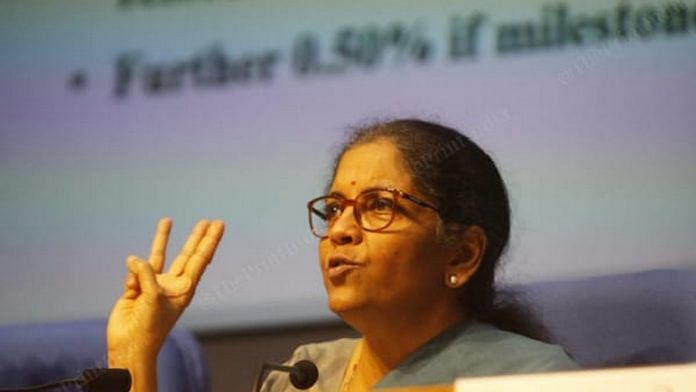Mainstream papers focus on the lockdown extension till 31 May, but note that this time the Centre has passed the baton to states and union territories to demarcate red, orange and green zones based on the spread of Covid-19.
The mergers and privatisation of PSUs as part of the final tranche of the ‘AtmaNirbhar Bharat’ package is also a hot topic on papers.
Pink papers point out the lack of bold measures in Sunday’s announcements and Business Standard anticipates an “outlay for the health sector to improve infrastructure in blocks”.
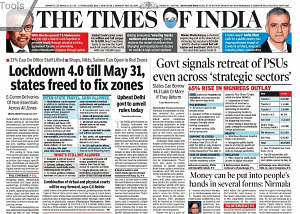 The Times of India leads with the extension of the national lockdown — ‘Lockdown 4,0 till May 31…’
The Times of India leads with the extension of the national lockdown — ‘Lockdown 4,0 till May 31…’
‘Lockdown 4.0’ will see considerable leeway being given to states “in reopening of market places”, allowing “intra-state and interstate passenger vehicle and bus travel” and doing away with “the 33% staffing restriction for businesses,” it reports.
Meanwhile, in the fifth and last installment of the AtmaNirbhar Bharat package — a slew of financial reforms announced last week — Finance Minister Nirmala Sitharaman “unveiled the government’s plan to limit the role of public sector companies across the economy” says TOI in ‘Govt signals retreat in PSUs…’
In some grim news, the number of new cases that were reported in a single day surged to 5,000 “for the first time”. In ‘For the first time, the paper notes the “explosion of cases in Maharashtra, which reported a record 2,347 fresh infections”.
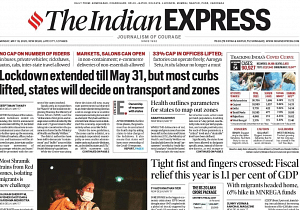 The Indian Express also leads with extension of the lockdown.
The Indian Express also leads with extension of the lockdown.
According to another report (‘Health outlines parameters for states…’), the delineation of the zones have to be determined as per the “parameters” set by the Ministry of Health and Family Welfare. “These include: the total number of active cases, active cases per lakh population, doubling rate over a 7-day period, case fatality ratio, tests per lakh population and sample positivity rate”.
An important report ‘Tight fist and fingers crossed…’ notes how the 1.1 per cent fiscal relief from the government “is unlikely to mitigate” the adverse impact of the Covid-19 pandemic on the economy. The culmination of all the packages announced in the past week by the Finance Ministry amounts to 1.1 per cent of the GDP, the graphic alongside the report explains.
The report also notes the National Council of Applied Economic Research (NCAER)’s prediction that the economy would contract by 12.5 per cent in 2020-21.
The report on the financial reforms announced by Nirmala Sitharaman focuses on the 65 per cent hike in MNREGA funds. It states that “the sharp hike indicative of the likely surge in demand for work in rural areas as migrant workers, who are travelling to their home towns amid the coronavirus lockdown, are unlikely to return to the cities soon for work”.
The anchor story is about the shocking case of an Ahmedabad man, who died five days after he developed Covid symptoms even though he had been admitted to a hospital at this time. “In those five day, leading up to Makwana’s discharge from hospital hours before he was found dead, they had (his family) had no information on his condition,” the story notes.
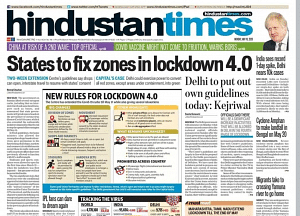 Hindustan Times notes the change in the guidelines regarding the Aarogya Setu app. While earlier the app was a must for people working in private and public sectors, the fresh guidelines says that “employers should put in their ‘best effort’ to ensure staff members install it”.
Hindustan Times notes the change in the guidelines regarding the Aarogya Setu app. While earlier the app was a must for people working in private and public sectors, the fresh guidelines says that “employers should put in their ‘best effort’ to ensure staff members install it”.
A subsequent report (‘Delhi to put out own guidelines…’) notes that the Delhi government will be putting out its own guidelines today. According to HT, “There will be a significant increase in permitted activities in line with Centre’s guidelines”.
Also, “desperate to return home to their villages” migrants are now crossing the Yamuna river from Haryana to Saharanpur. The small item ‘Migrants take to crossing Yamuna to go home’ notes that they are doing this “to avoid detection and detention at the heavily guarded border checkpoints”.
The  Telegraph in its lead (‘PSU domain shrinks…’) on the last installment of the AtmaNirbhar Bharat package said that Nirmala Sitharaman announcing a Rs 40,000-crore increase in rural employment scheme, “scuppered” the hopes that the central government “would provide salve to the destitute travellers streaming out of cities and industrial towns to face an uncertain post-Covid future”.
Telegraph in its lead (‘PSU domain shrinks…’) on the last installment of the AtmaNirbhar Bharat package said that Nirmala Sitharaman announcing a Rs 40,000-crore increase in rural employment scheme, “scuppered” the hopes that the central government “would provide salve to the destitute travellers streaming out of cities and industrial towns to face an uncertain post-Covid future”.
There’s a heart-wrenching report ‘Painkillers not package…’ about how migrants are relying on painkillers, not food, to make the painful journey back home. “The medicines help them bear the pain of cuts, blisters and swelling, offering temporary relief to keep them on their feet for a few hours more,” according to the report which is also accompanied by a picture of the worn-out feet of the migrants.
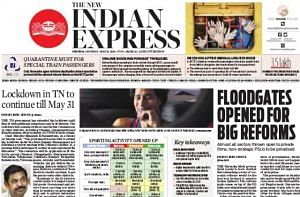 The New Indian Express’ second lead on the last installment of the AtmaNirbhar Bharat package is very tongue-in-cheek. In ‘FLOODGATES OPEN FOR BIG REFORMS’, it reports: “The Narendra Modi government seems to have decided that unleashing a wave of economic reforms would be the best way forward to catalyse the Indian industry”.
The New Indian Express’ second lead on the last installment of the AtmaNirbhar Bharat package is very tongue-in-cheek. In ‘FLOODGATES OPEN FOR BIG REFORMS’, it reports: “The Narendra Modi government seems to have decided that unleashing a wave of economic reforms would be the best way forward to catalyse the Indian industry”.
What’s more interesting is the analytical exposé. In ‘Centre’s outgo on stimulus package less than Rs. 3 lakh crore’, the daily goes through the AtmaNirbhar Bharat package with a fine-toothed comb to find that not much is being “paid out of the public purse”. It reports: “The five tranches of the economic package announced between May 13 and 17, had additional capital allocations worth Rs. 11.75 lakh crore, much of which includes credit guarantees”.
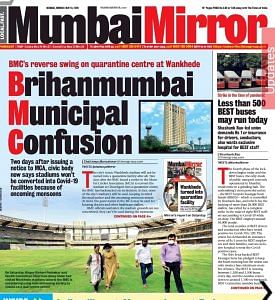 Mumbai Mirror in a report titled —Brihanmumbai Municipal Confusion — focuses on the rollback of the Brihanmumbai Municipal Corporation’s decision to convert the city’s iconic Wankhede stadium into a quarantine facility. According to the report, BMC officials reasoned that “since the stadium grounds are not concretised, they can’t be used during the monsoon”.
Mumbai Mirror in a report titled —Brihanmumbai Municipal Confusion — focuses on the rollback of the Brihanmumbai Municipal Corporation’s decision to convert the city’s iconic Wankhede stadium into a quarantine facility. According to the report, BMC officials reasoned that “since the stadium grounds are not concretised, they can’t be used during the monsoon”.
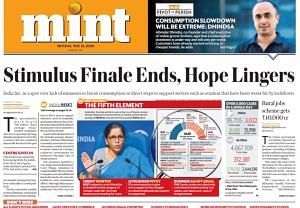 Mint seems unimpressed with the last tranche of the economic package. In ‘Stimulus Finale Ends, Hope Lingers’, it quotes chairperson and MD of Biocon, Kiran Mazumdar Shaw who said in a tweet: “The healthcare sector has been short-changed. No stimulus for hospitals who have to bear increased operating costs due to covid-related protocols”.
Mint seems unimpressed with the last tranche of the economic package. In ‘Stimulus Finale Ends, Hope Lingers’, it quotes chairperson and MD of Biocon, Kiran Mazumdar Shaw who said in a tweet: “The healthcare sector has been short-changed. No stimulus for hospitals who have to bear increased operating costs due to covid-related protocols”.
The paper chalks out six takeaways from the final tranche in an item titled ‘DON’T MISS’ at the bottom of the lead. These include, all flights to stay grounded, gates open for e-commerce, metros and schools to remain shut, work from home to continue and shops in markets to open.
A short anchor story, ‘Flight to safety comes with a little twist’, notes that growing uncertainty “has prompted a flight-to-safety with investors rushing to assets that are perceived as relatively safe”. However, there were some “contrarian bets too” — “net flows into equity mutual funds and exchange-traded funds (ETFs) recorded the highest growth in the three months between February and April”, it adds.
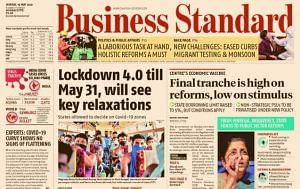 Business Standard points out a caveat in Lockdown 4.0: “Another change, according to the fresh MoHFW parameters issued on Sunday to chief secretaries by Union health secretary Preeti Sudan, is that states/UTs need not colour code an entire district as red, orange or green.”
Business Standard points out a caveat in Lockdown 4.0: “Another change, according to the fresh MoHFW parameters issued on Sunday to chief secretaries by Union health secretary Preeti Sudan, is that states/UTs need not colour code an entire district as red, orange or green.”
An “even a smaller administrative unit…like a sub-division, a ward or any other administration unit” can be colour-coded too, it adds.
The paper’s second lead, ‘Final tranche is high on reforms, low on stimulus’, is interestingly prefixed with the phrase: ‘CENTRE’S ECONOMIC VACCINE’. Contrary to what Mazumdar Shaw was quoted to have said in Mint’s lead, Business Standard anticipates reforms for the health sector.
It reports: “The government will increase its outlay for the health sector to improve infrastructure in blocks, but the FM did not specify by how much”.



